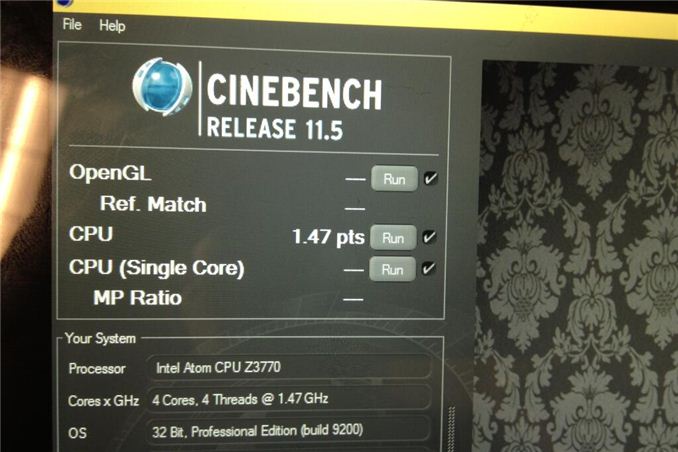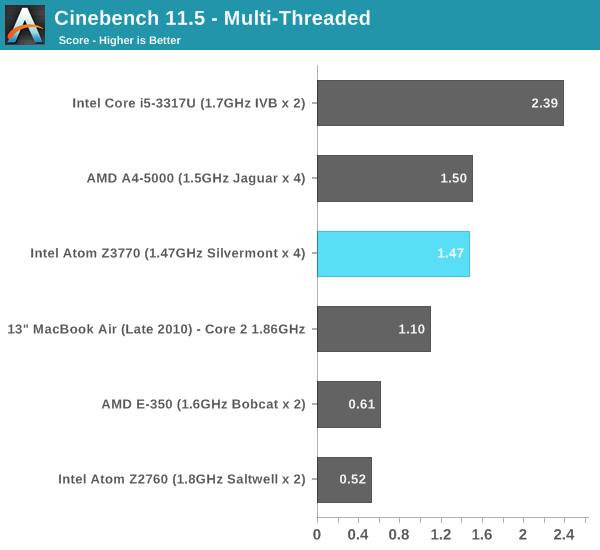Intel Teases Baytrail Performance with Atom Z3770 Cinebench Score
by Anand Lal Shimpi on September 4, 2013 12:49 PM EST- Posted in
- CPUs
- Intel
- Mobile
- Silvermont
- Tablets

Intel's lone ranger and Principal Engineer, Francois Piednoël, published one of the first semi-official Baytrail benchmarks on his Twitter feed earlier today. The score is for the unannounced Atom Z3770, a quad-core Silvermont based (4C/4T) Baytrail implementation running at a nominal frequency of 1.47GHz (with I assume a > 2GHz max turbo). Francois was careful to only run the multithreaded Cinebench 11.5 test, tossing out a score of 1.47.
To put this score in perspective we need to dig into some of our own reviews. AMD's A4-5000, a quad-core Kabini based SoC running at 1.5GHz, manages a score of 1.5 in the same test. This is also roughly 86% of the performance of a dual-core Sandy Bridge based Pentium processor running at 2.2GHz. Compared to a dual-core Atom Z2760 (Clovertrail) the Atom Z3770 delivers nearly 3x the performance. Finally, this Baytrail SKU delivers similar performance to a mid-2GHz mobile Penryn based Core 2 Duo. Let that sink in for a moment - this tablet SoC delivers better multithreaded FP performance than a 2010 Macbook Air. The quad-core Silvermont vs. dual-core Penryn comparisons are a little unfair as there tends to be no replacement for extra cores in these thread heavy benchmarks. If Intel is able to equal a Core 2 Duo's single threaded performance however...

Single threaded performance typically scales down quite linearly in Cinebench, but that's assuming that single core turbo frequencies aren't insane. Regardless it's probably safe to assume a single threaded Cinebench 11.5 score somewhere north of a 1.5GHz Jaguar. We are also only looking at FP performance here, which is less important for most consumer uses than integer based workloads.
It's interesting to note that the test system (likely a tablet) seems to be running a 32-bit version of Windows. As there are no connected standby enabled versions of 64-bit Windows, that's likely why we're seeing the 32-bit version used here.
Obviously the big unknown here is power consumption. As Baytrail is destined for tablets, I'd expect lower average power than pretty much all of our comparison targets in the graph above. The big question I have is whether or not this is finally performance that is good enough. Although Clovertrail could run legacy Windows applications, it wasn't fast enough to actually run heavy legacy apps well. Paired with a decent IO subsystem (something I'm doubtful most OEMs will deploy), I feel like Baytrail could be on the cusp of delivering performance that's good enough. Part of the problem here is that we're only looking at multithreaded performance, which obviously looks pretty reasonable on a quad-core part. How well Intel is able to deliver good single threaded performance will really determine whether or not Baytrail makes for a great platform.
With IDF 2013 next week I'm guessing we'll see a lot more of Baytrail's performance soon enough.










33 Comments
View All Comments
Wade_Jensen - Thursday, September 5, 2013 - link
So performance will come down to the thermal limits of the device. I wonder whether a 2-2.4GHz could be sustained for very long in a passively cooled device. Or are the rumoured 2.4GHz clocks likely only for the Pentium/Celeron branded low end notebooks? I think Dan is on the money for this one.Krysto - Friday, September 6, 2013 - link
Turbo boost is such a SCAM, from everyone using it, including Nvidia for their GPU's (and I guess AMD, too).Turbo-Boost frequency (more relevantly called "burst speed") is almost completely IRRELEVANT, because you'll not be able to use it for too long. The real speed is the base one, so 1.46 Ghz for Atom.
kyuu - Sunday, September 8, 2013 - link
In thermal- and power-constrained devices like tablets, you may have somewhat of a point. Anywhere else? You're very wrong. Turbo is utilized frequently and makes quite a bit of difference.tential - Wednesday, September 4, 2013 - link
Why mention Penryn then not include it in the benchmarks?I have penryn and if this is really faster then well, it's time to upgrade I guess. I'm using penryn 2.2ghz with a 9800MGTS and it still is serving me well. Been waiting for baytrail to see if I can upgrade. Would be funny to get a tablet that performed better than my old laptop all around. I know it's probably not possible to get that type of GPU performance lol but man..... this is ridiculous how intel is moving. I'm loving the dedication to mobile now.
purerice - Wednesday, September 4, 2013 - link
Same here, I have a Conroe-based desktop and a Penryn laptop that get about 1.3 and 1.1 respectively on Cinebench 11.5. When you use a spreadsheet and presentation software for 90% of your non-web browsing time, there's little incentive to upgrade.Both my processors have TDP of 35w and this bad boy is 4.5 or so. Pretty crazy to be 10% faster but use 1/8th the power.
If Bay Trail allows for more than 4gb ram and a good 1440p monitor, I'd jump.
Boissez - Thursday, September 5, 2013 - link
FWIW I tested an old system I have with a Q9300 quad @2,5 Ghz with 32-bit XP. It yielded a score of 2.84 in CB11.5.Or if one were to extrapolate the clocks Baytrail comes within 10% of Penryn in terms of IPC (or about the same as Kentsfield). Not too shabby.
aousy - Wednesday, September 4, 2013 - link
The question is how much will Intel sell it for. Sell it too cheap and it will cannibalize Celerons, sell it too high and nobody will buy it.Qwertilot - Thursday, September 5, 2013 - link
Never mind celerons, this stuff is (as you can see from above) logically positioned to take a huge swathe of the consumer market from the Core line. If not in this generation then certainly fairly soon. Much cheaper, passively cooled etc.It might well considerably improve the quality at the budget end too. Or maybe they'll manage to control it somehow so it won't.....
Roland00Address - Thursday, September 5, 2013 - link
it is ok for this chip to cannibalize Celerons because it die size is smaller than a Celeron it is a problem if this chip cannibalize the core seriesNovum - Thursday, September 5, 2013 - link
The problem with Cinebench is, that it's compiled with the Intel compiler which means that all SIMD optimizations are disabled on non Intel CPUs, which skews the benchmark considerably. No wonder Intel was choosing this and only this as a showcase.